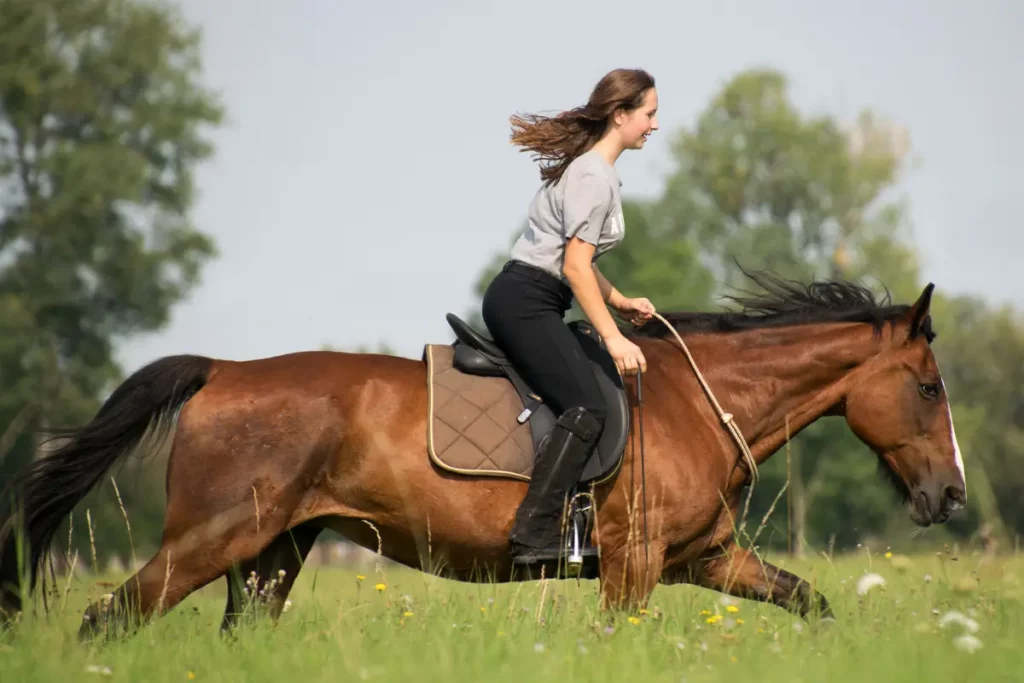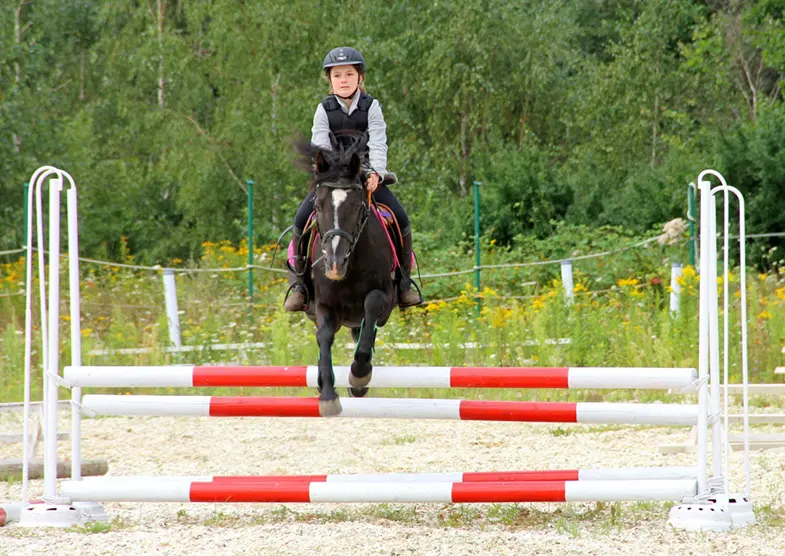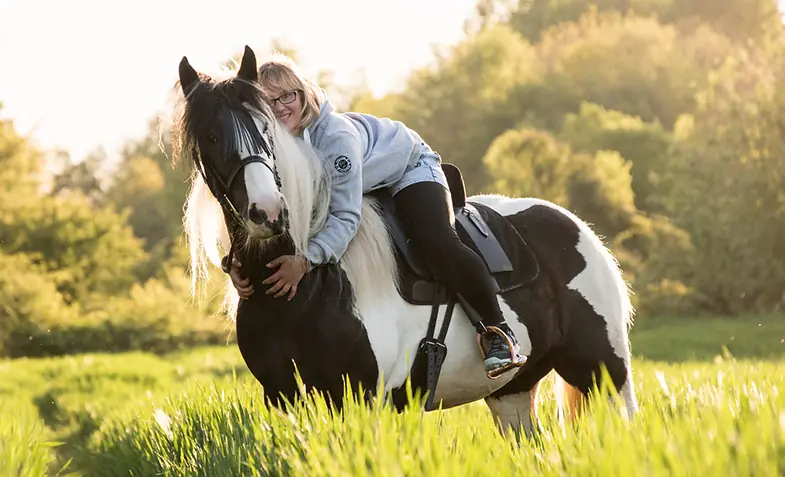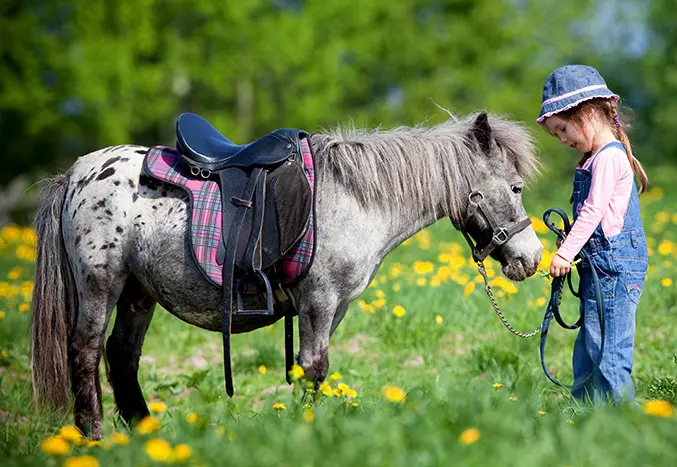Having taught hundreds of people to ride over the decades I’m often asked about the technicalities of horse riding and how difficult or easy it is. There is always one question though that I’m asked more than any other and that is ‘how long does it take to learn to ride a horse?’
As you can imagine this isn’t always a straightforward question to answer as the answer tends to be ‘it depends’ but that doesn’t help if you want to budget or plan for enough lessons. With this in mind, I decided to write this article, not only to explain why it sometimes depends but also to answer the question properly.
How long does it take to learn to ride a horse? It takes roughly 10 private lessons to get a basic understanding of how to ride a horse but to really master riding can take an average of 2 years. During this time you’ll learn to walk, trot, canter, and jump as well as how to steer and control a horse and how to maintain your balance in the saddle.
Learning to ride a horse is more than just getting on a horse and letting it follow the horse in front or follow a set route. To be able to really ride a horse you need to be able to control it fully, not just the direction it’s traveling in but also its speed. You’ll also need to maintain your balance, regardless of speed, which means that you’re not pulling on the reins, pressing on the horse’s neck, or crashing down on their back. Once you’ve mastered this you can truly call yourself a horse rider but as you’ll discover there are a number of different factors that can alter how quickly you can do that.
How much time does it take to learn to ride a horse?
Learning any new skill takes time and patience but if your new skill is learning to ride a horse there are a number of other factors that will also play a role in how long it takes. Things such as a rider’s age, how driven they are, their athletic ability, and natural talent can all play their part. How much time they spend in the saddle, their budget and the quality of the instructor can also make a difference.
Age
It doesn’t matter how old you are when you learn to ride but the younger you are the more flexible both your brain and your muscles are. This means that your brain will find it easier to absorb new information quickly and your muscles won’t ache as much and will therefore recover much faster.
While this might not seem like it matters at first it does make a difference to how frequently you’re able to ride, or at least how quickly your muscles recover will between rides.
Motivation
It might sound still to say that motivation can play a role in how long it takes to learn to ride a horse but it can make more of a difference than you realize.
While it’s better to learn to ride at as younger age as possible if you’re learning because your parents are pushing you to do it then you’re already giving yourself a handicap which means it’ll take longer. Likewise, if you want to learn to ride yourself but are getting frustrated with how long it’s taking you’ll, understandably, lose motivation and therefore begin to lose interest in learning altogether.
I’ve also found that while children who want to learn normally don’t have any problems staying motivated I’ve also found that adults who have an end goal find it easier to remain motivated as well. If you’re looking forward to going for long trail rides or dream of competing at show jumping then keeping that goal in mind and working towards it will help. If you don’t have a particular goal then I find it can help to set yourself goals. With the help of your instructor, these can be smaller goals such as working towards cantering on your own, popping over a small jump, or mastering a rollback.
Physical and mental fitness
While good riders make it look easy there’s a lot more to riding a horse than just sitting on its back. It’s a physically demanding sport that will use muscles you didn’t even know existed. You’ll need to use your legs, back core, and even your shoulder muscles just to keep yourself in the saddle and well-balanced.
You’ll need to be strong enough to be able to control the horse, fit enough to cope with the strain learning will put on muscle groups you’ve never used, and mentally tough enough to deal with any setbacks, and believe me there will be some but it’s all part of the learning process.
It’s not essential but I always advise new riders to make sure they have some strength in their core muscles before starting. This helps them to sit better in the saddle which is crucial for learning to ride.
Natural ability
There’s no doubt that some people have a natural aptitude for horse riding that will obviously make it quicker and easier for them to learn but that doesn’t mean to say you can’t learn if you don’t have the ability. After all, while people like Michael Jordan or Tom Brady clearly have a natural talent it doesn’t mean to say that their teammates can’t play, and horse riding is no different.
Ability to follow instructions and retain information
In time riding a horse will become second nature but at first, there’ll be an awful lot of new things to take in. This means that if you’re able to follow and act on your instructor’s direction you’ll pick things up much quicker.
At first, you’ll probably only be riding once a week which is why it’s also helpful if you can easily retain everything your instructor has told you. This means you won’t have to spend time refreshing your memory every time and get on with that week’s lesson.
Hours spent in the saddle
Horse riding is an expensive hobby which means it’s not always possible to have multiple lessons each week but the more time you can spend on a horse the better. If you’re not able to have a lot of lessons then why not ask some horse owners if you can carry out tasks for them (such as cleaning the stall, grooming their horse, etc) in return for a short ride on their horse. Even a few extra minutes just feeling the horse can help you to understand them which will speed up your learning.
Understanding of horses
I know I’m stating the obvious by saying that the more time you can spend in the saddle the quicker you’ll learn to ride but it’s not just about spending time in the saddle, spending time around horses will also help.
Like all living creatures horses have their own personalities and their own ways of doing things as well as their own language and by spending time with them will help you to understand how they work and how to read what they’re thinking. This is a crucial ability for any good rider.
Instructor and horse
The ability and expertise of your instructor will have a huge impact on how quickly you learn to ride a horse. The better your instructor understands you and the horse, as well as how they convey their instructions can all make a difference.
While we don’t like to admit it, how well you get on with your instructor also makes a difference. After all, not everybody gets on with everybody and if you don’t feel you can confide in your instructor it’ll take you longer to learn because you’ll have to overcome any hurdles yourself, without their help.
Likewise, the role the horse plays in learning to ride can also have a massive effect and one that is often overlooked. If you’re a nervous rider and are riding a bolshy horse it’ll take you a lot longer to learn if you’re constantly having to fight your nerves. Whereas if you’re riding a gentle horse then you can concentrate on the task at hand.
When I first started to learn to ride I remember deciding I didn’t want to do it anymore, I told my instructor I wasn’t feeling well so would sit the lesson out until my parents turned up to collect me. My instructor knew exactly what was going on and wouldn’t have any of it, instead, she found a nice quiet horse (called Fuzzy) for me to ride. Anyway to cut a long strong short I fell in love with this horse and with horse riding again and haven’t looked back since. This is why I say the horse’s personality is crucial when you’re learning to ride.
Riding instructors often use phrases and terms that can be alien to new riders, but having a basic understanding of what your instructor means when they say something will help a lot too.
Budget
How much you’re able to spend on riding lessons is often the single biggest factor in how long it takes to learn to ride. If money is no object private lessons will help you to learn quicker than group lessons but most people don’t have the budget for 100% private lessons.
A good alternative, if you have the budget for it, is a mixture of group and private lessons where you have one group lesson and one private lesson a week. Yes, this is the most expensive option but you’ll find it’s also the quickest way of learning unless, of course, you have two or more private lessons a week.
Patience
I know I mentioned this earlier but if you stop thinking about how long it’ll take to learn to ride you’ll find you’ll learn much quicker than if you keep accessing your progress after every lesson. I’m not saying you should think about your progress at all, but instead leave the analysis to your instructor and just enjoy the ride (sorry I couldn’t resist the pun), you’ll learn much quicker if you do, and have more fun!
What age is the best to learn to ride a horse?
Any riding school will tell you that the vast majority of their students are under the age of 20 and there’s a very good reason for that. Of course, you can learn to ride at any age but the younger you are the better it is for a few reasons.
Adults are more developed than children which, although it is an advantage in most circumstances, it can be a disadvantage when learning a new skill. Not only are adults more set in their ways, but their muscles aren’t as malleable and as willing to learn something new as those of a child. As well as being more able to learn something new children are also more willing to learn.
While some riding schools allow toddlers and start lessons as soon as a child is able to sit up by themselves and hold the reins properly most won’t teach children until they’re at least 6 years old. This is because by this age they’re not only more able to follow instructions but they’re also more likely to understand what is being asked, they also have better coordination by this age too.
It’s also worth noting that if a very young child is learning to ride they should only have short lessons due to the pressure the riding helmet can put on their necks. Young children don’t have the strength in the muscles in their necks to be able to hold their heads and a riding helmet up for prolonged periods of time.
When is it too late to learn to ride a horse?
The younger you are the quicker you learn and the easier you’ll find learning to ride a horse but that doesn’t mean that if you’ve not started by the time you reach your twenties you shouldn’t bother. If you’re healthy and fit enough to be able to get onto the horse and have the physical strength to be able to control them then there’s no limit to when you start learning to ride.
A few years ago I taught a 70 year old lady to ride, she’d always wanted to learn but family and work commitments got in the way so she hadn’t got round to learning before. While this is inspiring in itself what I found really amazing was that not only was she much older than most new riders but she was also completely blind! Now if a blind person can learn to ride a horse at 70 then there’s no reason why you couldn’t begin to learn in your 30s, 40s, 50s, or even 60s.
Is it hard to learn to ride a horse?
Ask any horse rider and they’ll tell you that it’s not difficult at all, but if you as the same question to somebody just starting to learn and you’ll get a very different answer. That doesn’t mean that either of them is wrong, just that they’re looking at it from completely different ends of the spectrum.
The best way of answering the question of whether or not it’s difficult to learn to ride a horse is to say that it can be both physically and mentally difficult to learn but once you’ve mastered the basics you’ll find that the rest of the learning curve is much easier, and much more fun too.
Want to correct bad habits? 14 common riding mistakes and how to fix them.
How many lessons does it take to learn to ride a horse?
There are no definitive answers to how many lessons it takes to learn to ride but there is a general assumption that after 10 private lessons you’ve learned enough to be able to walk, trot, and possibly canter on your own but this isn’t realistic for more people’s budgets, nor is it the end of the story.
There is an argument that says you can learn to ride a horse within 40 hours, but there are also people who say that to really master horse riding you need to spend around 1000 hours in the saddle (if you have a hour long lesson a week that’s almost 40 years). In my opinion, neither of them are honest or practical answers. Instead, I’ve found, from my own experience, that it takes around 100 one-hour lessons to be a good, competent rider.
How much does it cost to learn to ride a horse?
The cost of learning to ride can vary drastically depending on where you’re learning, how good the instructor is, how you learn, and the length of the lesson. Lessons can range from a 15 minute introductory lesson to a two hour in-depth session but most people opt for a one hour lesson although these can also range in cost.
I called a number of schools throughout the States and have found that Las Vegas is the cheapest with private lessons costing around $60 and group lessons (with up to 6 riders) costing roughly $30. New York, on the other hand, is by far the most expensive with private lessons typically costing $100 and group lessons starting at $80. The average cost for horse riding lessons in the US though is $50 for group lessons, $63 for semi-private lessons (with groups of two or three riders), and $75 for fully private lessons.
I hope you found this article helpful. If you did I’d be grateful if you could share it please as it would really help me.
Recommended products
Over the years I have tried hundreds of different horsey products, from various blankets and halters to different treats. Some I’ve loved, others I’ve hated but I thought I’d share with you my top all-time favorite products, the ones I never leave the yard without. I’ve included links to the products (which are in no particular order) that I really think are great.
- Horse Knots by Reference Ready – If you’re like me and enjoy pocket reference guides then you’ll love this knot tying guide. These handy cards can easily fit in your pocket or attach to the saddle for quick reference. They’re waterproof, durable and are color coded to make them easy to follow.
- Mane ’n Tail Detangler – Even if you never show your horse you’ll need to detangle his tail from time to time (and possibly his mane too) which is always a challenging chore! I’ve found that if I run a little bit of detangler through my horse’s tails every few days it stops them from getting matted up and makes combing them easy, even if they’re coated in mud. I don’t know if I should admit to this or not but it also works wonders on my hair.
- TAKEKIT Pro clippers – Over the years I’ve tried a lot of different clippers and while some were obviously better than others I found these to be by far the best. They are heavier than a lot of other clippers but for me, that’s a good thing, it makes them feel more sturdy and hardwearing. On top of that they have a range of speeds so are just as good for clipping your horse’s back as they are his face. I also like the fact that they come in a handy carry case but that’s not for everybody. The company that makes them is super good and incredibly helpful too, a real bonus these days. The only thing I wasn’t keen on was the fact that it doesn’t come with any oil, but that’s not a major problem as it’s not difficult to buy lubricant.
- Shire’s ball feeder – There are so many boredom buster toys out there but I like to use these every day, regardless of whether or not my horses are bored. I find that it helps to encourage my horses to problem solve by rewarding them with treats (or pieces of fruit) but it also mimics their natural grazing behavior which helps to keep them calm and de-stressed.
- Horse safe mirror – This is a strange one that many people are surprised about but I like to put horse safe mirrors in the trailers as well as in the quarantine stalls. It helps to prevent the feeling of isolation by giving the impression of other horses being around. Being herd animals horses can get extremely stressed when they feel that they’re on their own but with these stick-on mirrors, they believe that at least one other horse is with them.
- Rectal thermometer – I know this isn’t glamourous at all but it’s vital for your horse’s well-being to be able to check their temperature and a rectal thermometer is the easiest way of doing this which is why I’ve added it to the list.
Shopping lists
I’ve also put together a few shopping lists of essential items that I’ve found helpful over the years. I’ve broken the lists down into different categories rather than put everything in one massive list 😉





